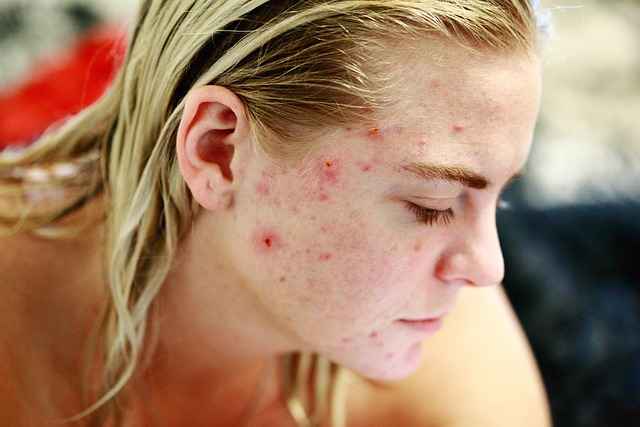Dark Spots on the face may be caused by hyperpigmentation, which occurs when the skin produces too much melanin.
There are a variety of therapies, both medical and cosmetic, as well as home cures, that can help eradicate or decrease them.
Numerous dark blemishes on the face do not pose any danger. To diminish their appearance, however, most people turn to topical treatments available in various formulations.
The dark spots that develop as a consequence of hyperpigmentation will be discussed in this article. This post will discuss skin blemishes, their types, and how to remove blemishes on the face.
What Is Skin Blemishes?

Skin blemishes are any marks or spots on the skin that aren’t normal, or you don’t want. They can be caused by things like acne, getting older, being in the sun, changes in hormones, and even your genes. Dark spots, age spots, freckles, hyperpigmentation, melasma, and scars are all types of skin blemishes.
These dark blemishes on the face can be harmless and just for looks or signify a more serious skin problem. No matter what causes them, skin marks can be unsightly, and many people look for ways to improve their skin.
Types Of Skin Blemishes

Acne: Acne is a common skin problem that affects people of all ages. It causes whiteheads, blackheads, and pimples to form on the face, neck, chest, and back.
Age Spots: Age spots, often called liver spots, are dark skin areas that appear due to age and sun exposure. Most of the time, they are on the face, hands, and arms.
Freckles: On skin exposed to the sun, freckles are tiny, flat brown patches that often occur. They happen when the skin’s colour-giving pigment, melanin, makes more of itself.
Hyperpigmentation: Hyperpigmentation is a condition in which an overabundance of melanin causes some skin parts to darken. The sun, hormone changes, and some medicines can cause it.
Melasma: Melasma is a skin disorder that often affects people and results in dark areas on the face, mainly on the cheeks, nose, forehead, and upper lip. It usually happens to women and is thought to be caused by hormone changes like pregnancy or hormone therapy.
Scarring: Acne and other injuries to the skin often leave scars. It happens when the skin is hurt, and the body responds by making too much collagen. This can leave scars that are raised or sunken.
Varicose veins: These are swollen veins, usually in the legs and feet. They can make your skin get dark spots and change colour.
How To Remove Skin Blemishes And Dark Spots Permanently?

The appearance of skin blemishes affects many individuals. They may be brought on by several different things, including becoming older, spending too much time in the sun, experiencing hormonal shifts, or having acne.
Even though a wide selection of creams and treatments may be purchased without a prescription, they can be pricey and may not provide the needed outcomes.
You may, however, permanently erase skin imperfections and dark blemishes on your face using a few of the many natural ways available to you. Let’s learn how to remove blemishes fast:
#1. Lemons Juice
Lemon juice is a natural component used for several years to brighten and lighten the skin. Because it includes citric acid, it removes dead skin cells, revealing brighter and more transparent skin.
To utilize lemon juice, squeeze the juice from one lemon and apply it straight to the region that needs treatment. It should be left on for ten to fifteen minutes before being washed off with warm water.
For optimal outcomes, carry out these steps two to three times every week on skin blemishes.
#2. Aloe Vera
Another natural component that is useful in eradicating skin blemishes and dark blemishes on the face is aloe vera. This ingredient can be seen in numerous skin care products. This ingredient’s anti-inflammatory and moisturizing characteristics aid in calming and moisturizing the skin.
In contrast, this ingredient’s enzymes help eliminate dead skin cells and encourage cell regeneration. To use aloe vera, one only just removes the gel from an aloe vera leaf and then applies it straight to the region that needs treatment.
It should be left on for around 15–20 minutes before being removed with warm water. For optimal outcomes, carry out these steps two to three times every week.
#3. Apple Cider Vinegar
Apple cider vinegar has been used topically as a natural cure for several skin conditions for centuries. It has alpha hydroxy acids, which assist in exfoliating the skin and eliminating dead skin cells.
These acids may be found in it. Additionally, it has antibacterial and antifungal characteristics, which help remove infections that may be a factor in developing dark blemishes on the face and blemishes.
To use apple cider vinegar, dilute it with water by the ratio of one part vinegar to two parts water, and then apply it to the afflicted region immediately.
It should be left on for ten to fifteen minutes before being washed off with warm water. For optimal outcomes, carry out these steps two to three times every week.
#4. Potato Juice
Another valuable natural component to remove skin blemishes is potato juice, which can be found in most grocery stores. Its starch content helps to soothe and moisturize the skin, while its enzymes assist in the removal of dead skin cells from the body’s surface. To get potato juice:
- Grate a potato and then press the grated potato to extract the juice.
- Apply the juice to the afflicted region and keep it on for ten to fifteen minutes before washing it off with warm water to remove any residue.
- For optimal outcomes, carry out these steps two to three times every week.
#5. Honey
Honey is a natural substance that has been used for several years to treat wounds and to keep the skin hydrated. It is rich in antioxidants and antibacterial qualities, which work to rid the skin of any infections that may be a factor in the appearance of dark spots and blemishes.
Honey may be used to treat various skin conditions by simply applying it directly to the problematic region, allowing it to sit there for ten to fifteen minutes, and then washing it off with warm water. For optimal outcomes, carry out these steps two to three times every week.
Difference Between Blemishes And Pigmentation
People often use the words “blemishes” and “pigmentation” interchangeably, but they don’t mean the same thing.
Blemishes are any markings or spots on the skin that are unnatural or undesirable, regardless of the source of the mark or spot.
Acne, growing older, spending time in the sun, fluctuations in hormone levels, and even your DNA may all contribute to their development. Scars, freckles, age spots, hyperpigmentation, melasma, and dark skin patches are all common skin imperfections.
Pigmentation, on the other hand, is the term for how the skin gets its colour. It depends on how much pigment melanin, which gives skin its colour, is made by melanocytes. Hyperpigmentation is a type of pigmentation that happens when melanin makes the skin darker in some places than it should be.
In short, pigmentation is the colour of the skin, while blemishes are any marks or discolourations on the skin that are not normal or wanted. Hyperpigmentation is a kind of skin discolouration that can lead to spots on the skin.
FAQ-
How To Remove Blemishes On Face Naturally?
Scars and blemishes may be removed using lemon juice, a natural bleaching agent.
Cocoa butter, baking soda, apple cider vinegar, potato juice, neem, papaya, oatmeal mask, shea butter, yoghurt mask, and turmeric mask are natural substances that may help erase pimples.
